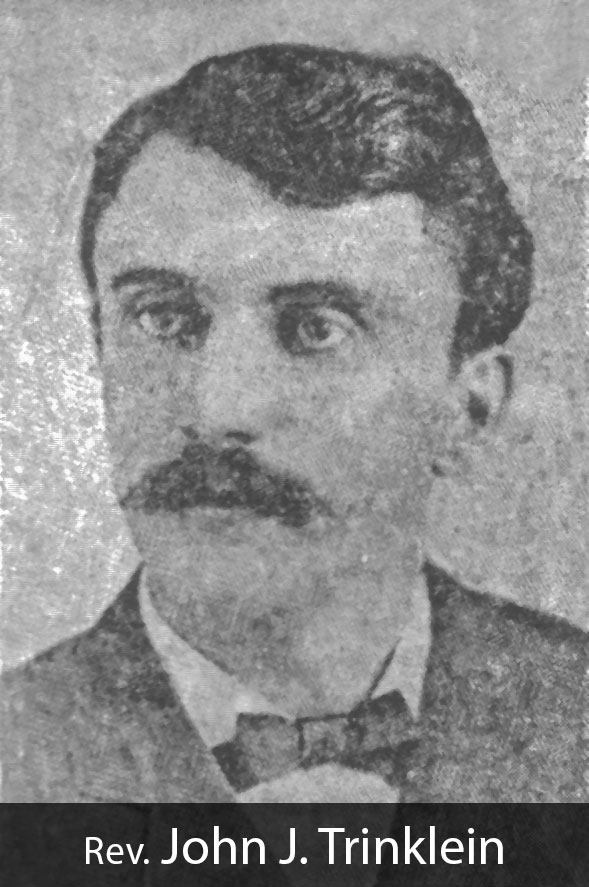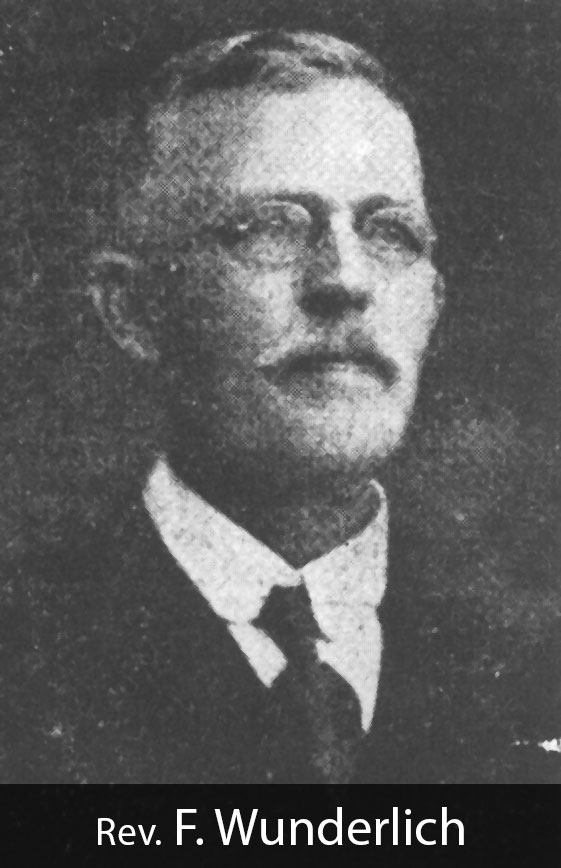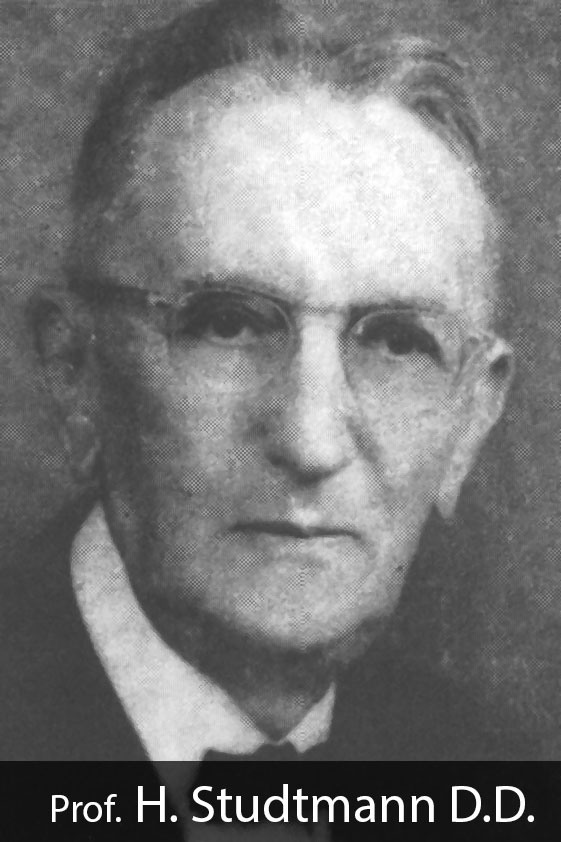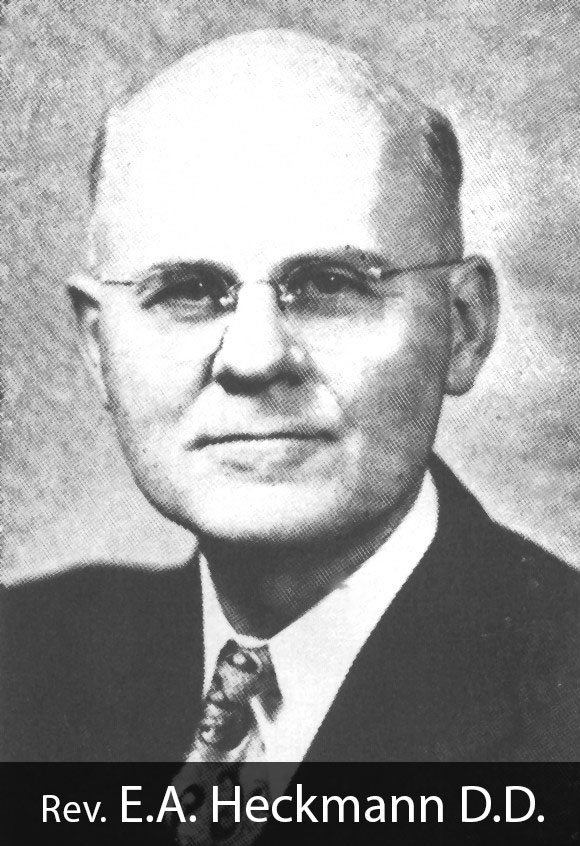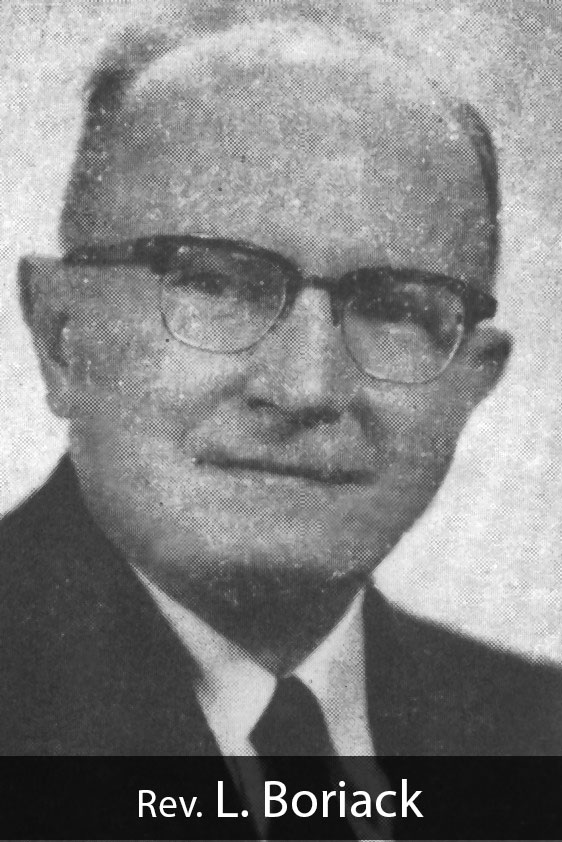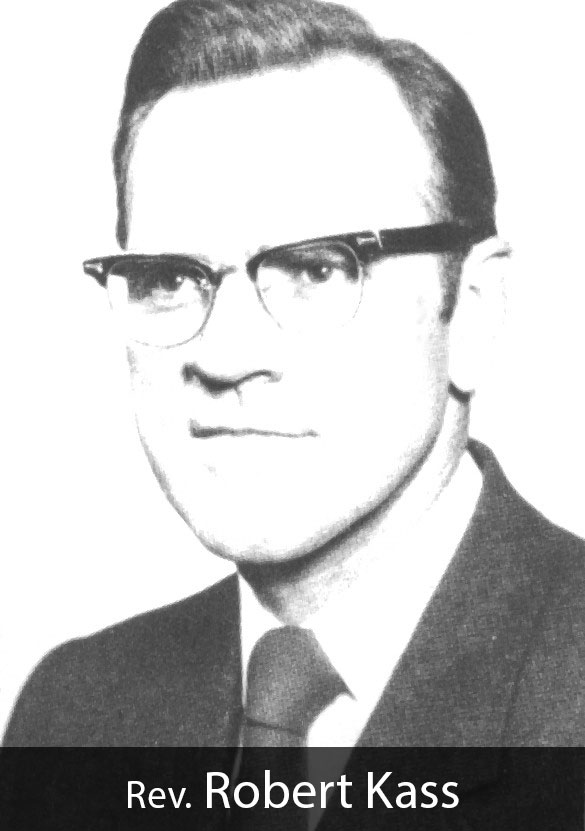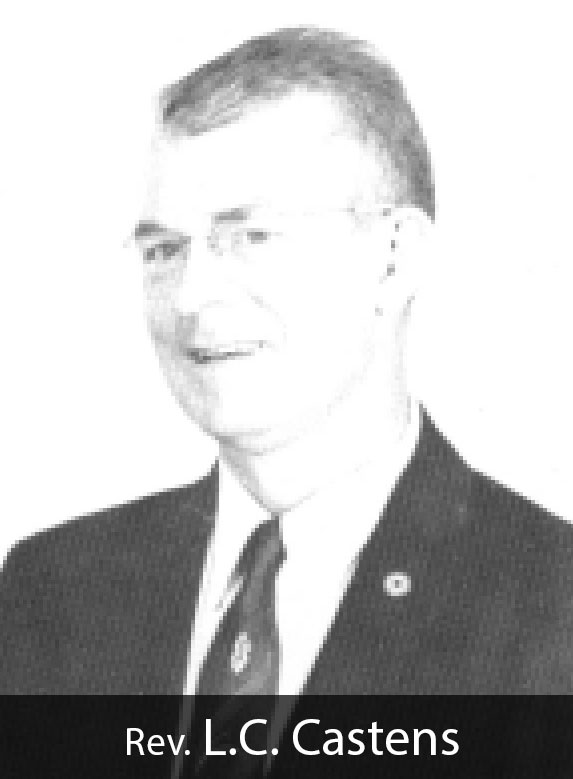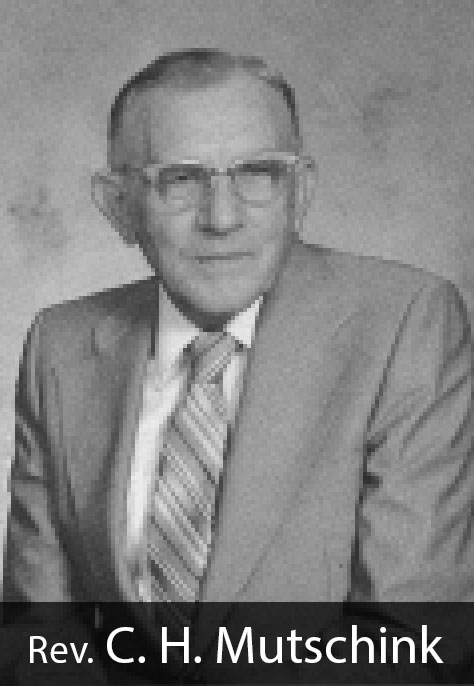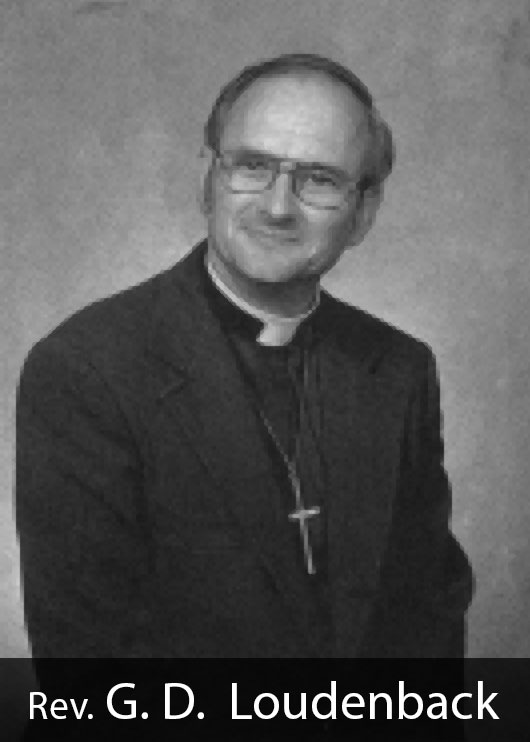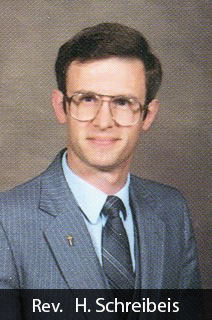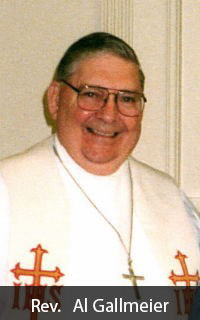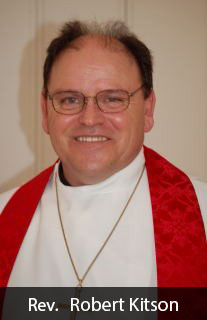HISTORIC TRINITY LUTHERAN CHURCH
Riesel, texas
Some things are worth the effort, like driving along country roads in search of something special. And special it is!
It first appears on the far horizon, rising up on the swell of rich black Brazos River Valley farmland. Then its simple but classic lines come into focus: a white-framed citadel, anchored by its stout steeple pointing heavenward. One senses, even before reading the State of Texas Historical Marker which welcomes member and visitor alike, that this has been and still is a truly special place (a holy place!). Its care and keeping by loving hands and dedicated hearts is much in evidence wherever one looks.
The story of Trinity Evangelical Lutheran Church at Friedens Au (as the area was then known) begins in 1882 when an energetic missionary, the Rev. John Trinklein, was called from Michigan by the Southern District (eventually becoming the Texas District in 1906) of the Lutheran Church–Missouri Synod to gather scattered Lutherans in the heart of Texas. It was a Spirit-inspired vision, for Lutheran congregations back then were few and far between in the Lone Star State.
The Lord blessed those early labors, and by the following year the original gathering of some fifty Lutherans was officially organized as Trinity Evangelical Lutheran Church. The first building was immediately erected on a four-acre site. The next year the congregation called its first resident pastor, the Rev. F. Wunderlich and simultaneously established a parochial school. Special, indeed! In just three years (from 1882 to 1884) Trinity had been transformed from a mere idea to an already thriving congregation.
The years became decades, and the growth continued. More people, more facilities, more opportunities. From 1904 through 1946 Trinity was served by two outstanding pastors, the Revs. Henry Studtmann and E. A. Heckmann, both of whom served as President of the Texas District during their pastorates. When the present church was dedicated in 1937, Trinity was the largest Missouri Synod congregation in Texas.
It was also during this time of growth and development that Trinity Church served as the source for the organizing of daughter congregations in neighboring communities: Battle, St. John; Marlin, Grace; Mart, Grace; Otto, Zion; and Waco, St. Mark.
Times change, and the post-war years had their impact upon Trinity Church and its mission as population centers shifted from the farm to the city. The next six decades would be marked by a series of relatively short-term pastorates, although each of these faithful servants of the Word has left his mark and blessing upon the congregation. This strong pastoral heritage is one of the significant ways by which the Lord continues to bless our congregation with health and vitality.
Youth have always been a priority at Trinity Church, from its early founding of a parochial through its emphasis on confirmation instruction and youth-related activities to its present-day Early Childhood Learning Center. The first called teacher was Herman Schmidt (1906-11), whose ministry created a wonderful tradition of committed teachers and volunteers whose various talents have touched and are still touching the lives of so many young Christians.
Resting in the hope of our Lord’s resurrection are the saints interred in Trinity Lutheran Cemetery. In its first month as a congregation (July 1883) Gottlieb Fenske was laid to rest. The continuing presence of the cemetery behind the church boldly testifies to the presence of both the Church Triumphant and the Church Militant.
Historic Trinity Lutheran Church is special! Its heritage is rich with God’s
abundant blessings. And by God’s grace its continuing ministry remains healthy and vital. You are invited to experience this special gift of God’s goodness for yourself.
HISTORICAL OUTLINE
1882 - The Southern District (by 1906 the Texas District) of The Lutheran Church–Missouri sends Missionary John Trinklein to begin the work of organizing scattered Lutherans in the Riesel area.
First worship service is held in the home of Gottfried (George) Ebner on December 5.
1883 - The first church is built and services begin in June. The church is officially named
“Trinity Evangelical Lutheran Church at Friedens Au” (as the area was then known).
Trinity Lutheran Cemetery is established.
1884 - The first full-time called pastor, F. Wunderlich, is called and installed in September. A room is added to the church and Trinity Lutheran School begins.
1891 - A second church is dedicated in October, only to be destroyed by a violent windstorm in May, 1892.
1893 - A third church is dedicated in June.
1906 - The first full-time called teacher, Herman Schmid, is installed in September.
1908 - A schoolroom is added to the church as Trinity Lutheran School expands.
1937 - A new larger church (which remains to present) is dedicated in December.
1942 - A new school, separate from the church, is dedicated in September.
1945 - Trinity serves as the host for the LCMS Texas District convention.
1947 - A new teacherage is built.
1958 - A parish hall behind the school is constructed.
1969 - The current parsonage is built.
1980 - The current Parish Haus is dedicated.
1983 - Trinity Church celebrates 100 years of God’s blessings.
1989 - The current organ is installed and dedicated.
1996 - The Early Childhood Learning Center is established.
2000 - A new Early Childhood Learning Center building is constructed.
2008 - An extensive five-year restoration project climaxes as Trinity Church celebrates 125 years of God’s blessings.
CALLED PASTORS
Founding Missionary, John J. Trinklein (1882-1884)
F. Wunderlich (1884-1904)
Henry Studtmann (1904-1926
E. A. Heckmann (1926-1946)
A. F. Michalk (1946-48)
P. J. Braner (1948-50)
Louis Boriak (1951-56)
Erwin Sanders (1958-59)
Robert Kass (1960-63)
Louis Castens (1964-74)
C. H. Mutschink (1976-79)
G. Donald Loudenback (1980-84)
Howard Schreibeis (1985-88)
Stephen Linck (1989-97)
A. E. Gallmaeier (1999-2005)
Robert Kitson (2005-present)
CALLED TEACHERS
Herman Schmidt (1906-1911)
J. C. Jackel (1911-1914)
A. O. Waiser (1915-1928)
T. R. Bethke (1929-1943)
Theodore Schroeder (1944-1948)
Fred Meyer (1949-1953)
H. E. Weiser (1954-1965)
Trinity's History
The Southern District of the Lutheran Church Missouri Synod began the work of organizing scattered Lutherans of Texas into congregations. To open these new mission fields a notice was placed in “Der Lutheraner”, asking all readers to relay to the newly organized Mission Board the names and addresses of Lutherans living in Texas but not served by a pastor.
REV. TRINKLEIN: 1882 - 1884
The first missionary-at-large to be called was John J. Trinklein. He was to receive a salary of $40.00 per month plus his living expenses. In his memoirs, he stated that he actually received $25.00 per month. He spent three to five nights a week on a train, traveling up and down the length of the Houston & Texas Central Railroad. The president of the railroad gave Rev. Trinklein a free pass because he knew towns usually formed around church congregations. It was known that Rev. Trinklein was a man of extraordinary skills and possessed great stamina and passion for his calling. These two attributes served him well when he began his journey to Texas where he braved cold, storm, floods, and traveled on virtually impassible or nonexistent roads. He came from Frankenmuth, Michigan on August 23, 1882. Initially he was assigned to work out of Hockley, about 35 miles west of Houston. There he made the home of Mr. and Mrs. Jacob Scherer his base and covered the rural areas to the west, northwest, and southwest of Houston. By 1885 Rev. Trinklein had reached out to the scattered Lutheran groups in over a dozen different areas of Texas, including a small gathering of Lutherans near Riesel, then known as Friedens Au, which translates to Meadow or Prairie of Peace. Rev. Trinklein first arrived in Perry, Texas on a cold December 2, 1882. He spent the next three days busily searching out prospects in the Perry area to invite to a church service at the home of Mr. George (Gottfried) Ebner on December 5, 1882. On this date the first divine services were held in the Ebner home. About fifty people sat in the two large front rooms of the house. The liturgy was sung by the pastor and responded to by the congregation. Church services continued to be held in the Ebner house till May 1883. During this time, arrangements for building the first church were taken care of by the members. The name of this church was TRINITY EVANGELICAL LUTHERAN CHURCH AT FRIEDENS AU.
Henry Fenske Sr., hi wife, Ottillie, & son, Henry Fenske Jr.
Otto Rau
REV. WUNDERLICH: 1884 - 1904
The first full-time pastor at Trinity was Rev. F. Wunderlich. Rev. Wunderlich was ordained and installed at Trinity in September 1884. He was born July 13, 1860 in Klein, Texas and studied at the Lutheran Academy of New Orleans during its short existence and Concordia College, Ft. Wayne. He graduated from Concordia Seminary at St. Louis. At the time Rev. Wunderlich accepted the call to serve Trinity Riesel, he was also assigned the duty of being responsible for the preaching places between Waco and Houston that Rev. Trinklein had started earlier. In particular, he was to minister to the Kurten and Willow Hole areas (later renamed North Zulch). In the year following his installation as pastor of Trinity, on April 16, 1885, Rev. Wunderlich was united in marriage with Bertha Klein. Their union was blessed with thirteen children (nine sons and four daughters). As the first resident pastor of Trinity, Rev. Wunderlich knew the value of a Christian education. In 1884 a room was added to the back of the church building to accommodate the growing number of students at Trinity's parochial school. In 1888 a vicar was called to serve the North Zulch area. Rev. Wunderlich was then able to devote more of his time to Trinity Church and its day school. Eventually, he served as the school’s full-time teacher. Rev. Wunderlich believed that the youth are our future and started a youth organization along with the school. The early Youth Society participated in the choir and various other functions of Trinity. In the late part of the 19th century and the beginning of the 20th century, such things as television, computers, and movies did not exist. The youth created their own activities. This Christian fellowship came in the form of meetings that included a call to order, a prayer, and Bible study. Socials were held that consisted of a meal, a party, or skating. The skating parties were usually held at the Perry Gymnasium on a Saturday or Sunday afternoon. Cars were not available. People traveled in buggies or on horseback.
During Rev. Wunderlich’s tenure, Trinity’s congregation grew so much that a new sanctuary was needed. In 1891 church members began planning for a second church building to be built. The plans were lofty indeed. They called for two rows of pews at the floor level and a raised altar and pulpit section which would be equal in height to the balconies which surroundedthe interior of the church on all sides. The choir would sing from the balcony, while communicants would kneel at one side of the altar rail to receive the bread (the body of Christ). They would then walk to the other side of the altar and kneel at that rail to receive the wine (the blood of Christ). The church had a beautiful spire steeple which was visible for miles across the rural landscape. Sadly, the beautiful sanctuary was completely destroyed by a violent windstorm in May 1892. Despite the tragic loss of their building, the members of Trinity were not deterred and refused to let this tragedy hinder their worship of God. Almost overnight, a third church building arose on the previous site. Its design was much like the second church, having a towering steeple that was visible for miles. Balconies surrounded three sides of the church. One balcony served as the place for the choir to sing. Another balcony served as the place for the organist and organ. The last balcony served as an extra seating area for the smaller children of Trinity. This church served the congregation for 45 years until its membership simply outgrew the church building.
Third Church Interior
DR. STUDTMANN: 1904 - 1926
Trinity’s third pastor was Rev. Henry Studtmann, who was installed at Trinity in May 1904. Rev. Studtmann was born in Chicago in 1875, the son of a German cabinetmaker. As a boy, he left home to attend classes at Concordia College in Ft. Wayne, Indiana. He prepared for his theological training at Concordia Seminary in St. Louis, Missouri. He graduated from Concordia Seminary in 1897. He then served as pastor of parishes in Beloit, Wisconsin and at congregations in Crowley, Jennings, and Iota, Louisiana. He brought a growing family to Trinity Riesel where he faithfully served its members for twenty-two years. Under his pastorate, the church had a membership of 573 baptized and 282 communicant members by 1906.
Because of the large membership, the Christian Day School became too much for one person. Church members decided to call a full-time teacher, a first for the school. Trinity’s first full-time teacher for its school was Herman Schmidt. He served until he retired in 1911 due to recurring health problems. Trinity was not the only Lutheran congregation that was growing and prospering by 1906. This demonstrated a growth of approximately two new congregations per year.
Trinity Riesel bore fruit to become the seed from which several new congregations sprang up. Among these daughter congregations was St. Mark Waco, St. John Battle, Grace Mart, and Grace Marlin. St. Mark Waco was begun in 1916 by candidate Gus H. Biar. Some ground work was laid by Candidate W.F. Urban, called in 1912 to serve the Waco mission and to act as missionary to the communities of Battle, Mart, and Marlin. Rev. Geo. C. Falsken was the first to serve these rural communities in 1910 and 1911. Rev. Urban served them until he resigned in 1915, and Rev. E.M. Zabel served from 1916 until 1924.
As the Southern District continued to grow, the Missouri Synod Lutheran congregations in Texas became dissatisfied with their image as being a far-flung outpost on the periphery of the Synod. The Lutheran Church Missouri Synod’s convention was held in 1906 at Trinity Lutheran in Houston. The man chosen to serve as the Texas District’s first president was Rev. A.W. Kramer of Thorndale. Rev. Kramer had come to Texas in 1890 to serve as a missionary-at-large in the Coryell-Copperas Cove area. With President Kramer’s acceptance of the gavel, the Texas District had finally become a reality and a truly functioning unit of the Missouri Synod. It was in this Texas District that Rev. Studtmann’s leadership abilities were fully realized. Rev. Studtmann was a man of many talents which served him well as pastor, educator, and administrator. He was also keenly interested in music and was a respectable carpenter, a skill he learned from his cabinetmaker father. He displayed his love of music during worship and frequently directed the choir, in addition to delivering the sermon.
During these years Trinity had a band. This group of young men met to practice music, not for the pay, but for the love of the musical harmony and the friendly association of fellow band members. The instruments they played were well-used, but the musical sounds were enjoyed by all. They played famous old marches and waltzes such as “The Blue Danube Waltz”. Many of the band members either rode horses or walked, carrying their instruments to practice. They played for the annual church picnics and other community activities when they were invited to play. As a rule, the principal of the parochial school was the church musician and also directed the band. Teacher Alvin Waiser is remembered well as one of the band directors. Some of the band members were: Alwin Klawitter, Ed Reuwer, Otto Klawitter, Chris Lehrmann, Walter Lehrmann, Paul Abel, Edwin Abel, Fritz Paar, Paul Paar, August Mueller, Rudolph Boeche, Ernest Berg, Herman Pick, Otto Koester, Emil Londenberg, Walter Gaskamp, B.T. Fenske, Herman Reinke, Martin Quiran, Theo Kluck, John Ruhnke, Teacher Schmidt, Max Studtmann, Fritz Pick, and Herman Koester.
In 1923 the first parsonage was razed and was replaced with a new pastor's dwelling.
Assistant Teachers & Harold Heckmann
Ebner House & Family
The founding members were:
- Mr. & Mrs. Philip Raedle and two boys
- Mr. & Mrs. F.H.W. Gaskamp and child
- Mr. & Mrs. Wetzel
- Mr. & Mrs. George (Gottfried) Ebner
- Mr. & Mrs. Wiebusch and son
- Mr. & Mrs. Fellechner and son
- Mr. Mueller Sr. and his son
- Mr. Otto Rau
- Mr. Brueggemann
- Mr. & Mrs. Jacob Fenske and grandchild
- Mr. & Mrs. John Fenske and three children
- Mr. & Mrs. Zander and their children
- Mr. & Mrs. Schultz and two children
To these founders were added: Mr. & Mrs. Henry Fenske and four children, Mr. & Mrs. Fleischhauer and two grown sons, Mr. & Mrs. Kuehl and son and son-in-law, two Norwegian brethren, Mr. & Mrs. Kophal and children, a number of citizens, and several students from Herr Von Schluembach’s institute.
Phillip Raedle & Family
In 1886 Rev. Trinklein ended three years of hard work in the mission field and accepted a call to Trinity Houston where he served until 1889. His death was reported in the Riesel Rustler in January 1947. He was 87 years old.
Mr. & Mrs. Charles Kophal & Sons
Boy standing is first child to be baptized at dedication of the first church of Trinity Lutheran Church
The first classroom for Trinity School was added to the back of the church. (above)
Second Church (October 1891 - May 1892) (above)
Third Church (June 1893 - May 1937)
Third Church Interior
The First Parsonage
The Second Parsonage - built in 1923
Rev. Gallmeier and Dr. Cedel, President of Concordia University, with Dr. Studtmann's walking stick. This photo was taken at a sesquicentennial folk celebration at Concordia in 2004
Rev. Studtmann also enjoyed art, with his favorite drawings being horses. He had a favorite horse named Sam. By riding Sam, he soon learned where all the members of his congregation lived. By the end of Rev. Studtmann’s pastorate in 1926, Trinity had grown to the largest Lutheran congregation in the state of Texas.
At the time the Texas District was formed in 1906, Rev. Studtmann admirably served the district as its first secretary, later as its vice-president, and finally as president for seven years. In 1926 Rev. Studtmann accepted the call of being the first president of Concordia College in Austin. When Rev. Studtmann left Trinity, the congregation, non-Lutheran community members, and area political leaders honored him with a “surprise” farewell reception. It was quite an event. Many automobiles, mostly model T's, with their lights off, lined the roads near the parsonage. When given the signal, they turned on their headlights and approached the parsonage. During the reception, Rev. Studtmann was presented with a magnificent walking stick. During his years at Concordia, the walking stick always remained nearby, in his office.
Concordia College was guided by Rev. Studtmann through its birth, guarded and nourished by him during its growing period, and raised up to maturity before Rev. Studtmann turned its care over to his successor in 1949. Rev. Studtmann continued teaching at Concordia on a modified service basis until 1958. At the time of his death on April 7, 1964, he still used an office at Concordia and busied himself writing his memoirs. Rev Studtmann's body lay in state on April 9, 1964, near the chancel of Birkmann Memorial Chapel on Concordia's campus, with a candle burning at his head and one near his feet. What a fitting tribute this was to his dedicated service to the Lord.
REV. HECKMANN: 1926 - 1946
After Rev. Studtmann accepted the call to Austin, Trinity began the search for his replacement. Trinity’s prayerful search led the congregation to extend a call to Rev. E.A. Heckmann of Zion Lutheran Church in Abilene, Texas. The challenge of leading the largest congregation in the Texas District seemed overwhelming to the 36 year-old pastor of Abilene, but after lengthy correspondence and the persuasive pen of Rev. Studtmann, he accepted the call in June 1926. The Abilene church was Rev. Heckmann’s first call and he had been ordained there in 1913. Rev. Heckmann was born at Ft. Wayne, Indiana on May 19, 1890. He was the son of a farmer and grandson of a charter member of the Missouri Synod Lutheran Church. He attended Concordia College at Ft. Wayne, Indiana and then went on to complete his studies at Concordia Seminary in St. Louis, Missouri. Rev. Heckmann and his wife, the former Concordia Mueller of Pittsburg, raised a family of seven children (five sons and two daughters). All five sons became ministers in Missouri Synod Lutheran Churches.
Rev. Heckmann was installed by Dr. Studtmann on August 8, 1926. The church was crowded “to the walls” and the weather was hot. The following Sunday, Rev. Heckmann nervously delivered his first sermon from the high pulpit above the Wendish-style altar to an equally large crowd. That same Sunday night, many members gathered on the lawn of the parsonage and welcomed the new pastor with kind words and tables loaded with food made by the ladies of the congregation.
Rev. Heckmann experienced another challenge in finding all his members in homes that were spread out in many directions and on roads that only his members could follow. Fortunately several willing members took the pastor around in all directions from the church. It was not quite so simple when Rev. Heckmann tried to retrace those many roads. Even though there were no street names or numbers on the house doors, the pastor eventually found his way. Many of the activities at Trinity were dependent on the weather. In their memoirs, Rev. Trinklein described the area's “black waxy accumulation of fertile soil”, and Rev. Heckmann described the black soil as “bottomless after a heavy rain.” The roads turned to quagmires after a good rain and seemed to eat gravel voraciously. In 1908, the Riesel Rustler announced, “The road from the
H.&T.C.R.R. (Houston & Texas Central Railroad) to the Lutheran Church will undergo a grading, the like of which has never been witnessed by any road in the county.” Twenty eight years later, the road was promised again and was finally constructed by the W.P.A. shortly thereafter.
At the first voter’s meeting, Rev. Heckmann met with 60 to 70 seasoned and timeworn men. This was quite an increase from the 10 to 15 men that Rev. Heckmann had become accustomed to in Abilene. During another voter’s meeting, it was decided to hold a German service and an English service each Sunday morning. During his many years in the ministry, Rev. Heckmann baptized more than a thousand babies. In those days, confirmation classes were large and often meant packing 20 - 30 children into the vestry in the back of the church. They did not all get a chair or school bench. Many sat on the steps leading up to the high pulpit in the church. But it all worked! The largest number of confirmands in any one class at Trinity was 37. This class was confirmed in 1930 by Rev. Heckmann. There were many young people in the congregation. In 1927 Rev. Heckmann organized a Young People's Bible Class. In 1937 this organization joined the International Walther League. Meetings were held twice a month to have Bible studies and “topic” discussions. Occasionally, softball games were played with other Cen-Tex leagues. The group presented comic plays, such as “Simple Simon Simple”, and earned a few dollars for League projects. These plays were put on in the Riesel High School Auditorium. In 1939 a large contingent of Trinity Leaguers attended a Walther League Rally at Thorndale, transported there in a roomy seed truck borrowed from a local cotton gin. At church meetings and parties it was not unusual to see 60 or more of the youth playing on the spacious lawn. One big event for the youth every year was the New Year’s Eve Party. It naturally included the ringing of the church bell to welcome the New Year and a “warming” snack of hot cocoa and cookies. With such a youthful congregation, there were many weddings. The weddings occurred mainly in the fall of the year and on Thursday afternoon or evening so that everything could be in order again for the coming Sunday.
In the summer of 1929, Trinity Lutheran Ladies Aid was organized under the guidance of Rev. Heckmann. Twenty members attended this first meeting. Also in 1929, Trinity opened a second Christian Day School in Otto in hopes that Trinity's members who lived in that area would eventually become the nucleus of a new congregation. Zion Lutheran Church in Otto was organized as a self-sustaining church. It immediately sent out a call for a pastor. On February 12, 1933, Rev. Wm. Hannusch was installed. Rev. Hannusch was a native of Smithville, Lee County, Texas. He had studied at St. John's College in Winfield, Kansas and completed his theological studies at Concordia Seminary in St. Louis. He graduated in the spring before his call to Zion. The new congregation reached its highest membership in 1937 with 199 baptized members and 130 communicant members.
By 1937 Trinity’s church roll consisted of 640 baptized and 440 communicant members. A new facility simply had to be built. Many members, former members, and friends of Trinity who were baptized, confirmed, or married in the third church were on hand to write FINIS to the third church building. The overflow crowd filed out of the third structure for the final time on August 1, 1937. The following day, the beginning of the demolition of the chapel began under the management of the building committee and the building was razed by members of the congregation. The work progressed and by Saturday night the building was demolished. On August 9 work began on the foundation of the present structure and on August 22, 1937, the cornerstone from the third church was laid in what was to become the front of the fourth church, before a large gathering of members and friends of the congregation.
The entire cost of the new building, including inside furnishings, but not the new organ, had already been paid for, in full, by members of the congregation. And some money was left over for the new organ. During the weeks of construction, the Trinity congregation conducted services in the Riesel Fair Park building, thanks to the courtesy of the Riesel Fair Association. The pews from Trinity were moved into that building and everything possible was done to make it comfortable and convenient for those who wished to attend. The auditorium was frequently filled to near capacity. After colder weather set in, Riesel High School authorities permitted the use of that school's gymnasium for services. In the weeks preceding the happy occasion, plans were implemented to make the dedication day one of praise and rejoicing. On Sunday morning, December 19, 1937, the new Trinity Evangelical Lutheran Church of Riesel was dedicated to the service of the Triune God: Father, Son, and Holy Ghost. With appropriate ceremonies, the doors of the church were opened by Rev. E.A. Heckmann. Dr. Studtmann, at that time the president of Concordia College in Austin, preached the dedicatory sermon in German. An English language service was held at 3:00 in which Rev. Studtmann was also the guest speaker. A large crowd attended both services, singing their praises to God: “Holy, holy, holy! Lord God Almighty! Early in the morning, our song shall rise to thee.”
Other buildings were also erected during this time. In 1942 it became necessary to build a new school. Financial conditions were at a low point so soon after the dedication of the new church. However, a generous bequest to Trinity by Mrs. Sarah Ebner (widow of Gottfried Ebner; the Ebners married late in life and had no children), together with contributions by members of Trinity, allowed this hope to become a reality. Some new lumber was bought for the construction, but much of that used was from the original school. Most of the construction work was done by the members themselves. The “modern” two-room school was approved by the State Board of Education. The school board members at the time were Mr. Hugo Dieterich, Mr. August Fleischhauer, Mr. Chris Lehrmann, and Mr. Albert Meyer. A unique feature of the new school was its centered porch which was frequently used as a stage in future years. Dedication ceremonies were held on September 13.
....more coming soon.
